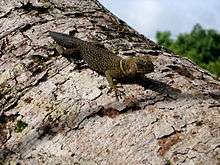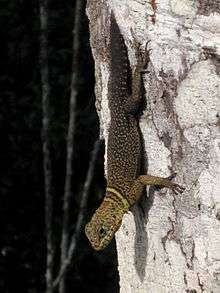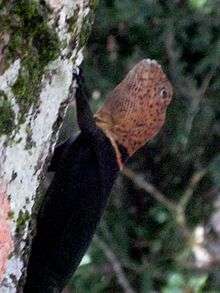Uracentron flaviceps
| Tropical thornytail iguana | |
|---|---|
 | |
| Scientific classification | |
| Kingdom: | Animalia |
| Phylum: | Chordata |
| Class: | Reptilia |
| Order: | Squamata |
| Family: | Tropiduridae |
| Genus: | Uracentron |
| Species: | U. flaviceps |
| Binomial name | |
| Uracentron flaviceps (Guichenot, 1855) | |
 | |
| Approximate distribution of the Tropical Thornytail Iguana (in Brazil, its distribution extends as far east as the lower Madeira River[1]) | |
| Synonyms | |
| |
Uracentron flaviceps, the tropical thornytail iguana or Amazon thornytail iguana is an elusive species of medium sized arboreal lizard found in the tropical lowlands of the Amazon Rainforest. The species was described by French zoologist Alphone Guichenot in 1855.[2] They are considered to be ant specialists and exhibit communal nesting and a harem style breeding system in which there is one male to multiple females. Study of this species has been impeded by difficulties collecting and observing the species.[3]
Taxonomy
The species was originally named Doryphorus flaviceps by Guichenot in 1855. Since its original identification, the species has undergone a number of taxonomic changes. In 1881 it was renamed Uranocentrum flaviceps by O'Shaughnessy.[2] This change did not last very long and the name was changed to Urocentron castor in 1885. There were only minor taxonomic changes after 1885 until a change to Uracentron flaviceps in 1925.[2] This name lasted until 1992 when Darrel R. Frost renamed the species Tropidurus flaviceps. The name switched between Tropidurus flaviceps and Uracentron flaviceps until 2003, when the genus Tropidurus was split into several genera and the Tropical Thornytail Iguana was assigned to Uracentron.[2][4]
Distribution
The species has been noted in the lowlands of eastern Ecuador, eastern Peru, northwestern Brazil, and in the extreme southern regions of Colombia, they may be found in Bolivia as well.[2][5]

Habitat
Tropical thornytail iguanas are only found in the Amazon rainforest, and within the rainforest are generally found in lowland tropical rainforest; usually areas with lagoons, rivers, streams, and palm swamps.[3][4] They are an arboreal species, spending the majority of their life in high tree tops.[4] They prefer trees with high horizontal branches that allow for basking in the sun during the morning hours, and are almost only found in trees that contain hollow areas accessible through entrances in the tree branches and trunks.[3] No specific species of tree has been found to be favored by the lizards, it would appear the tree structure, rather than the tree species, is what the lizards prefer.[3]
Physical description
Males can reach up to 13 cm (5.1 in) in snout–vent length, while the smaller females only reach 9.5 cm (3.7 in).[1] They have a large, flat tail covered in scales that end in a point; the function of these scales is currently unclear. The body is brown in color, speckled with yellow or gold spots.[4] Some specimens found in Ecuador and Peru were noted as having a black collar around their necks. This collar is bordered by narrow light colored edges.[5]
Sexual dimorphism

Sexually mature males differ from females, and juveniles in appearance, and it has been hypothesized that this may be the result of sexual selection.[3] The males display longer and deeper heads, as well as longer limbs when compared to females.[3] Females are also generally a little bit shorter in length than males.[4] Sexually mature males also display different coloration than females or juveniles. Sexually mature males have an orange head and black body, in contrast to the much more subdued coloring and yellow heads of females, juveniles, and not sexually mature males.[3] Males that reach sexual maturity also have enlarged testes when compared to those of males that have not reached sexual maturity.[3]
Feeding and diet
Tropical thornytail iguanas are considered a sit and wait, or ambush predator.[4] They are considered ant specialists, and various species of ants that wander the limbs and trunks of the trees inhabited by tropical thornytail iguanas make up a large percentage of their diet.[3][4] Larger lizards will eat slightly larger prey as well such as stingless bees, hemipterans (also known as true bugs), and beetles.[3] Interestingly alates, which have been established as a prey item of the tropical thornytail iguana are not usually present on the limbs and trunks of trees. It is possible that the lizards will break into the alate nests in the trees, or that they may only eat the species when releases occur. If they do break into the nests it is a highly unusual behavior, as rarely will an ambush predator actively seek its prey.[3] In studies investigating the eating behaviors of this species there was no difference in the amount of prey consumed between male and female specimens. This indicates that resource partitioning is not the reason for the difference in head size between and male and female tropical thornytail iguanas.[3]
Behavior
The species is diurnal, active during the daytime.[4] The level of activity exhibited is at least partially dependent on the presence of sunlight. Individuals emerge once the sun comes out, and will remain active unless cloud cover reduces sunlight. The approximate times of activity are from 8:30am until 5:00pm and males appear to emerge from holes in trees earlier than females and juveniles.[3] Upon emerging from the tree lizards will bask in the sun to raise their body temperature until activity body temperatures are reached.[3] When approached by humans or startled the lizards will either run into their holes to hide or run out on limbs of the tree to avoid whatever startled them.
Social structure

The tropical thornytail iguana has a resource defense polygyny social structure in which there is one sexually mature male to a group of females and juveniles. Resource defense polygyny means that the females do not necessarily live in extremely close quarters but the resources the females need are clustered together. This creates a group of females, and the resources they need, that a male can claim as his territory. This allows the male to be polygynous with minimal effort defending a resource-based territory.[6][7] In the case of tropical thornytail iguanas there is usually one group of lizards per tree with one dominant male. The structure of the system is usually one male, several adult females and various juveniles at different stages. In the few cases where there are two large adult males per tree it was found that the old male would take the dominant role and display the orange head and black body of a sexually mature male, whereas the other male will display the coloration patterns of an adult female. It has been mentioned that the lack of coloration shown by the younger male may be because the presence of a large old male suppresses the reproductive receptivity of the younger male.[3] In cases where there is only one lizard in a tree, it is generally a male without a group of females.[3]
Reproduction
The breeding season for this species appears to be extended, based on observations of juveniles of different sizes in a single tree.[3] During the breeding season males become more territorial and will engage in displays of head bobbing and body movements to warn away other males who may try to infringe on their territory. These displays are also used to attract a potential mate.[4] Like most reptiles tropical thornytail iguanas are oviparous and lay clutches of eggs. For this species clutches are usually 2 eggs per female, and clutches smaller than 2 eggs are very rare. The eggs are laid in nests deep within the holes of trees inhabited by a group of tropical thornytail iguanas.[3]
Conservation
The conservation status of the tropical thornytail iguana is currently uncertain, but it is thought that the loss of the species' preferred habitat to deforestation is the main threat to the species.[4]
References
- 1 2 Avila-Pires (1995). Lizards of Brazilian Amazonia (Reptilia: Squamata). Zoologische Verhandelingen 299(1): 1-706
- 1 2 3 4 5 http://reptile-database.reptarium.cz/species.php?genus=Uracentron&species=flaviceps, The Reptile Database - Uracentron Flaviceps
- 1 2 3 4 5 6 7 8 9 10 11 12 13 14 15 16 17 18 Laurie J. Vitt and Peter A. Zani (March 1996). "Ecology of the Elusive Tropical Lizard tropiduras flaviceps in Lowland Rain Forest of Ecuador". Herpetologica. 52 (1): 121–132. JSTOR 3892964.
- 1 2 3 4 5 6 7 8 9 10 http://junglephotos.com/amazon/amanimals/amreptiles/thorniguananathist.shtml, Thorntail Iguana Natural History
- 1 2 Harry W. Greene (June 1977). "Lizards of the Genus Uracentron (Iguanidae) in East-Central Colombia". Herpetologica. 33 (2): 256–260. JSTOR 3891504.
- ↑ Alcock, John. 1998. Animal Behavior. Sixth Edition. 429-519
- ↑ http://faculty.vassar.edu/suter/1websites/bejohns/mateselection/files/polygyny.htm, Polygyny